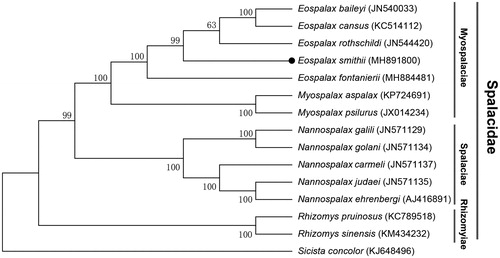Abstract
Sequencing analysis of mitochondrial genomes is useful for understanding the genome structures. In this study, complete mitochondrial genomes of the Eospalax smithii was obtained by using next generation sequencing method. The complete mitogenome of E. smithii was 16,350 bp long, containing 13 protein-coding genes (PCGs), 2 ribosomal RNA (rRNA) genes, 22 transfer RNA (tRNA) genes, and 1 non-coding control region (D-loop). The overall base composition of the heavy strand is A (33.65%), C (23.80%), T (30.31%), and G (12.24%). The base compositions present highly biased toward A + T nucleotides. The result of phylogenetic analysis showed the five Eospalax species formed a monophyly with the high bootstrap value and as a sister group of the genus Myospalax. This is the first report of the complete mitochondrial genomes of E. smithii and the mitogenome is potentially important for evolutionary biology, population genetics, and species diagnosis studies of the Mysopalacinae.
The Smith’s zokor, Eospalax smithii, is a typical subterranean rodent species and endemic in China (Fan and Shi Citation1982) belonging to subfamily Myospalacinae, family Spalacidae (Norris et al. Citation2004).
In this study, we successfully sequenced the first complete mitogenome of E. smithii by next-generation sequencing. The sample of E. smithii was collected from Gansu, China (N34.50°, E103.85°). Voucher specimens (No. MX-14) are stored at Key Laboratory of Adaptation and Evolution of Plateau Biota, Northwest Institute of Plateau Biology, Chinese Academy of Sciences. Total genomic DNA was extracted from muscle using DNeasy Tissue Kit (QIAGEN). An Illumina library was generated from genomic DNA and sequenced on an Illumina Hiseq 2500 platform. The complete mitogenome sequence of E. smithii was assembled, annotated, and analyzed.
The accurate annotated mitochondrial genome sequence of E. smithii (GenBank accession number MH891800) is a circular double-strand DNA molecule of 16,350 bp, containing 13 protein-coding genes (PCGs), 2 ribosomal RNA genes (rRNAs), 22 transfer RNA genes (tRNAs), and 1 non-coding region. The arrangement of the multiple genes is similar in line with other Myospalacinae species (Liu et al. Citation2011; Su et al. Citation2013; Li et al. Citation2016; Yuan et al. Citation2016; Cai et al. Citation2019). The overall base composition of the heavy strand is 33.65% A, 23.80% C, 30.31% T, and 12.24% G. The base compositions present highly biased toward A + T nucleotides. The heavy strand (H-strand) encodes 2 rRNA genes, 12 PCGs, and 14 tRNA genes, the ND6 gene, and 8 other tRNA genes are encoded on the L-strand.
Nine of all 13 PCGs initiated with an ATG start codon except for ND1, ND2, ND3 and ND5, which began with GTG, ATT, ATA and ATT start codon, respectively. Nine of the 13PCGs use TAA as the stop codon. The ND1, ND2 and CO1 are stopped with TAG, and ND4 end with incomplete stop codon T. The 12S and 16S ribosomal RNA genes are 941 and 1569 bp long, respectively. The tRNA genes vary from 60 to 75 bp in length and employ the anticodons typical of vertebrate mt-tRNAs. Twenty-one tRNAs had a typical secondary structure (cloverleaf structure) except the tRNA-Ser (GCT), whose complete dihydrouridine arm was lacking. A total of 9 mismatched base pairs (5 U–U pairs, 2 A–A pairs, 1 A–G pairs, and 1 C–A pairs) were detected in tRNAs secondary structures. In our study, the non-coding control region of the E. smithii mtDNA is 933 bp long.
Phylogenetic relationships were inferred from available mitogenomes of 14 species of Spalacidae using Maximum Likelihood (ML) method with 13 PCGs and 2 rRNAs. The results of phylogenetic analysis displayed that E. smithii formed a clade with other species belonging to the Eospalax genus, the monophylies of genera Eospalax and Myospalax was confirmed and they formed sister group, and Rhizomyinae was a basal clade relative to others within Spalacidae (). This mitogenome sequence of E. smithii would help in evolutionary biology, population genetics, and species diagnosis studies of the Mysopalacinae.
Disclosure statement
No potential conflict of interest was reported by the author(s).
Data availability
The data that support the findings of this study are openly available in NCBI Sequence Read Archive (SRA) at https://trace.ncbi.nlm.nih.gov/Traces/sra/sra.cgi?view=search_obj, accession number SRR11637901.
Additional information
Funding
References
- Cai Z, Zhang Y, Gao H, Song P, Zhang J, Zhang T. 2019. The complete mitochondrial genome of Chinese zokor (Eospalax fontanierii). Mitochondrial DNA B. 4(1):153–154.
- Fan N, Shi Y. 1982. A revision of the zokors of subgenus Eospalax. Acta Zool Sinica. 2(2):180–199 (Chinese).
- Li Y, Lu J, Wang Z. 2016. Complete mitochondrial genome of Manchurian zokor (Myospalax psilurus). Mitochondrial DNA. 27(2):1461–1462.
- Liu ZJ, Li YW, Shi FL, Lu JQ, Li M, Wang ZL. 2011. Mitochondrial genome of Plateau zokor Myospalax baileyi. Mitochondrial DNA. 22(5–6):174–175.
- Norris RW, Zhou K, Zhou C, Yang G, William KC, Honeycutt RL. 2004. The phylogenetic position of the zokors (Myospalacinae) and comments on the families of muroids (Rodentia). Mol Phylogenet Evol. 31(3):972–978.
- Su J, Wang J, Hua L, Gleeson D, Ji W. 2013. Complete mitochondrial genome of the Gansu zokor, Eospalax cansus (Rodentia, Spalacidae). Mitochondrial DNA. 24(6):651–653.
- Yuan S, Lu Z, Wu X, Fu H, Bao D, Malqin H, Yang S. 2016. Complete mitochondrial genome of Myospalax aspalax (Rodentia, Spalacidae). Mitochondrial DNA. 27(6):4250–4251.

